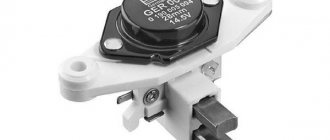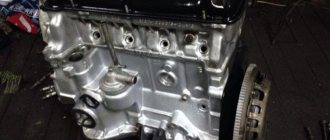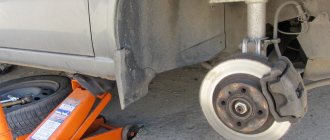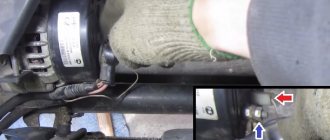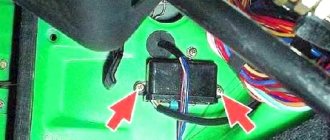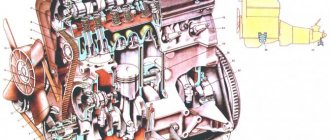Reasons for lack of spark
Often, owners may encounter cases of starting failure in the cold season, although the moped drove well in the autumn. Initially, you need to unscrew the spark plug and carefully inspect for spark, oiliness and color.
Carbon deposits on the electrode
There may be no spark, if the electrode is covered with carbon deposits, then they are cleaned with a metal brush. If there is even the slightest doubt about the serviceability of the spark plug, you should replace it immediately, thereby making your life easier in the future.
Acidification of contacts
If the external signs of the spark plug correspond to suitability, and there is also no spark, then you need to check whether there is a discharge. It is worth noting that you need to be extremely careful, as it can give you an electric shock. If there is no spark and the external signs of the spark plug are normal, then the scooter is checked electronically for acidification of the contacts.
Insufficient fuel
If there is a spark, but the moped still has difficulty starting from the starter in cold weather, you should pay attention to the fuel tank. If it is empty then it is filled
It is worth noting why old gasoline pours out of the carburetor float chamber. How to do it? There is a bolt at the bottom of the carburetor; it is unscrewed, and after all the fuel has flowed out, it is screwed back in. Before putting the moped in the garage in cold weather, fill the tank full of fuel.
Unscrew the bolt and pour out the old gasoline from the carburetor float chamber
If the above has been checked and done, and the scooter does not start well from the starter, then you can make the following repairs:
- The carburetor is removed and the air filter is cleaned;
- The carburetor is cleaned, the jets and channels are purged;
- Everything is coming back together.
Typical reasons
First of all, you need to check: the ignition and power systems. Carry out a check in those places that can cause the moped to move. The reasons why the scooter does not start, especially in cold weather, may be the following:
No spark in spark plug
The scooter does not start because there is no spark in the spark plug. In this case, you need to do the following: the spark plug is unscrewed and checked for suitability. Connects to the ignition coil using a wire. Placed on the cylinder. When the crankshaft rotates, the spark at the spark plug is checked. The scooter will not start if there is no spark at the plug, or there is a spark, but it is inconsistent.
Reasons for the lack of spark on the spark plug
Cold weather
The scooter may have difficulty starting in cold weather if there is a problem with the spark plug cap or its connector. In such a situation, the cap is unscrewed from the wire, and the wire is brought 0.3 cm closer to the metal motor element to crank the crankshaft.
A moped can carry current in cold weather. This happens due to the fact that there is contact with the exposed part of the wire and the metal element due to which the scooter starts.
Malfunctions in the power system
A moped may have difficulty starting in cold weather if there is a problem in the power system: lack of fuel or its excess. In this case, you need to check the following elements: gas tank, fuel tap, starting enrichment and fuel pump.
First of all, check the moped's fuel pump
Along with this, it is worth noting that the moped needs to be repaired, and parts should only be disassembled if there is complete confidence that they are faulty. It is best to install only new parts on the scooter, and not used ones, otherwise the engine, when started from the starter, will either work poorly or will not start at all.
Troubleshooting
Malfunctions of electrical equipment and fuel systems are the most regular of all problems that arise among scooter owners.
It often happens that a breakdown suddenly occurs to the scooter. Repairing the carburetor, as a rule, allows you to resume the functioning of your “faithful horse”.
Usually, to do this, it is enough to remove the carburetor, clean the dust from the outside and the tarry deposits of gasoline and other debris inside. Clean and blow out the air and fuel channels and jets, check the condition of the fuel needle and throttle valve, and then reassemble and adjust it.
Fixing more complex breakdowns at home is not always possible, since specific tools are often required that are not widely available.
Thus, for a technically literate person, repairing a scooter with your own hands will not be very difficult if you have minimal knowledge and skills in handling equipment, as well as the necessary tools.
002_moto_1211_080
GET IN - IT WILL NOT KILL! Some citizens believe that when repairing or diagnosing electrical wiring, you can get an electric shock. It's in vain. Modern motorcycles (as well as cars) have a voltage of 12 V. This voltage is absolutely safe for humans, for example, if you hold both poles of the battery even with wet hands, you will not feel anything. The only exception is the ignition system, where the voltage in the secondary circuit (armored wire - spark plug) reaches tens of thousands of volts. Here it is better not to grab with wet bare hands, although I have never heard of cases of a person receiving any injury from a high-voltage motorcycle wire. Conclusion: there is no need to be afraid of working with motorcycle electrics. Any household appliance operating on a 220 V network is much more dangerous.
If the engine does not start, it is not at all necessary to immediately “turn the switch” to the ignition system. Moreover, her refusals are extremely rare. Most often, the cause of failure to start is the wrong mixture: either too lean (when, for example, we start a motorcycle in the cold after a long break), or too rich (when on a hot engine the driver forgetfully pulled out the “choke” or after a fall, when gasoline leaks from the float chamber managed to “fill” the cylinder).
It also happens that during many attempts to start the motorcycle, the battery runs low and one malfunction is replaced by another: for example, the mixture may already be normal, but it is no longer possible to produce a spark when the battery voltage is low (and it can drop to 6 V during cranking with the starter) Maybe. In this case, before you disassemble anything, connect another battery to help or, if it is not there, try to start it with a kick.
Where is the battery located on a moped and how to connect it?
Now that we know how to start a scooter without a battery, it will be useful to think about where the battery is located on a moped. After all, it’s not worth driving for a long time without it, in any case. It is better to understand this in advance so that in the future you will know how to connect the battery yourself.
If you have a Chinese scooter model, the battery is located directly under the footrest. You just need to remove it, find a small rectangular hatch, behind which the battery is located. With Japanese models the situation is a little more difficult: the battery in them can be placed not only under your feet, but also in front, and even under the seat of your two-wheeled friend. As a last resort, you should look for the battery in the underseat space.
If you received a moped without a battery, before purchasing, carefully measure the niche in which the battery should be located. Only then go to the store for a power source. As a last resort, you can start a moped using one of the above methods, come to the store directly on it, and the seller will definitely select the right model for you.
Connecting the battery must be started so that the terminals, when placed in a niche, are located as close as possible to the wires. If the wires come out from the left, install the battery, turning the terminals to the left.
Now take two nuts (they are usually square) and two bolts, which should be included with each battery. The nuts need to be inserted into the terminals and “tightened” with bolts. After that, find the red ones among the wires: one is thin and the other is thick. Their ends are connected to each other by a terminal - this is the positive pole. The green or black wire will definitely be the negative pole.
Connect the wires correctly: minus to minus, and plus to plus. Now check the operation of the moped: if everything is connected correctly, the motor will start.
The scooter does not start, there is a spark, but gasoline is flowing - what should I do?
The scooter does not start, there is a spark, but gasoline is flowing - what to do to fix it. We diagnose faults in the field with our own hands and mind. So, no matter what kind of scooter you have, 2T (two-stroke) or 4T, you need to first remove the spark plug. However, you have already done this, since you checked that there is a spark. If the spark plug is wet, let it dry; if it is dry, then gasoline still does not flow into the chamber. This could be due to the carburetor, or due to problems with the timing belt and valves (if you have a 4T). It happens that the sprocket on Chinese scooters jumps by 1 tooth. But, before looking at the marks and getting into the timing belt, check the reed valve.
Petal - also vacuum, usually located under the gas tank. Create a vacuum through the tube from the carburetor - gasoline should flow. If it does not flow, then change the valve, or simply pierce the membrane with a wire and plug the vacuum hose with a stick.
Of course, if the scooter does not start, there is a spark, but gasoline is flowing, check the compression. You can try it on at a car service center, but if the scooter is 50-125 cc and has a kickstarter, the lack of compression is usually felt as an effort on the leg - if there is almost none, then the engine is kaput. We need to do a major overhaul. But it can also be limited to a burnt-out valve - repairing the head or replacing it will correct the situation. The valve usually makes itself known, chirps and makes extraneous noises before dying.
If there is compression, then you need to look at the carburetor and valve mechanism. Naturally, the carburetor breaks down more often. You can again look at the symptoms by looking at the candle - if it’s white, then there was a deficiency of the mixture, if it’s black, it’s over-enriched. Check the air filter or temporarily remove the pipe. Try spraying carburetor cleaner. It is not recommended to disassemble it without experience.
Again, it can clarify a lot whether the motor seizes or not. If there are no flashes at all, then most likely it is the timing belt or a burnt-out piston. If there are flashes, then the carburetor.
One thing is good, if the scooter does not start there is a spark, then your generator is fine. By the way, the spark may be weak, it is also better to change the spark plug and check the switch, but usually there are at least flashes in the cylinders.
news-online.info
news-online.info
Scooter won’t start – Scooter-Expert – online magazine about scooters and technology
There may be several reasons why the scooter does not start and the electric starter does not work at the same time; let’s look at the main ones:
- Let's say the battery is discharged or there is a problem in the circuit from the electric starter to the battery. You can try starting the scooter from kickstarter. However, if, after pressing the kick, it rotates freely, but does not rotate the crankshaft, you should check the condition of the teeth of the kick gear and ratchet. Perhaps after replacing the worn parts everything will be fine. Scooter won't start? Go ahead.
- The fuses could simply have blown. In this case, you should check the fuse (if one is used for the entire circuit), or several fuses, in particular the starter and ignition circuits. If they don't ring through, replace them.
- If the electric starter does not turn the crankshaft when you press the Start button, the battery may be dead. Check the battery. If it is discharged, you should start the scooter engine from the kickstarter and check the charge voltage; perhaps the battery has discharged due to incorrect charging current or due to its absence.
- If, after pressing the “Start” button, you hear the starter operating, but the crankshaft does not turn, you should definitely check the condition of the charter gears on the crankshaft and the adequacy of the starter overrunning clutch.
- You should also check the starter circuit for serviceability. Listen carefully to see if, after pressing the engine start button, you hear the characteristic clicks of the starter solenoid relay operating. If there are no clicks, you should use a tester to check the starter relay itself, the nearest electrical wiring, and the negative battery cable. Sometimes after cleaning the contacts of the battery or relay, the operation of the entire circuit is restored.
Now let's imagine a different situation. The battery is charged, after pressing the starter button, it cranks the crankshaft perfectly in normal mode, but the scooter does not start. In this case, the reasons are somewhat different, as are the options for solving the problem. Let's look at this point in more detail, identifying the main reasons why the scooter does not start when the electrics are running:
- Check the operation of the starting enrichment. If the problem is in the wiring of the concentrator, the problem can be solved only by soldering or replacing the wiring, but if the problem is in the starting concentrator itself, it is easier to replace it with a new one.
- If fuel does not flow from the gas tank to the carburetor float chamber, the scooter will not start precisely because of the lack of fuel. This may have been caused by a jammed needle valve in the carburetor float chamber. Remove the float chamber cover and check the operation of the shut-off needle.
- If your scooter is equipped with a fuel pump (devices with a bottom tank), the fuel pump may be faulty.
- The most basic thing is to check if there is fuel in the tank. Often even this point is ignored.
- Check to see if the fuel hose, filter, or fuel tap filter is clogged. This is where blowing the elements with compressed air helps.
- Check the vent hole in the gas cap (or elsewhere, depending on design).
- If there is a spark, but it is noticeably weaker than usual, the spark plug may be faulty. You should check the gaps between the electrodes, the contacts between the spark plug and the cap, as well as the battery voltage (for scooters that refuse to work without a working battery).
- There may be no spark at all. In this case, replacing the spark plug with a new one often helps.
- Check the air filter; it may be in critical condition and does not allow air to pass through to form a normal fuel-air mixture.
- Check to see if there is any air leaking into the carburetor bypassing the air filter, for example through the filter box pipe. The air leak noticeably depletes the fuel-air mixture and the scooter does not start.
- If the engine is two-stroke, a common reason that the scooter will not start can be damage to the crankshaft seals. Check if the seals in the area of the variator and generator are leaking.
- If the engine is a four-stroke, the crank chamber gasket may be damaged.
- It happens that a candle is filled with gasoline. In this case, it is better to try to start the scooter using a new spark plug. If one is not available, try wiping the spark plug electrodes with a dry cloth and try again.
It should be understood that this is only part of the main and most common reasons that the scooter does not start, and there may be much more serious problems in the wiring, engine, etc.
Why the scooter does not start with the button - we identify the reasons
A scooter is a practical vehicle, economical and easy to drive. Modern models are reliable and easy to maintain, but various problems may arise during the operation of the scooter.
One of the most common breakdowns is the failure of the scooter to start with the button.
As a rule, at first the scooter starts from the button every other time , and then does not start at all using the electric starter. How to be in this case?
To fix a problem, you need to identify the cause of its occurrence. As practice shows, there can be many such reasons, but there are also quite common ones.
We list the most common reasons and give ways to solve them:
- Fuel sensor malfunction. No matter how trivial it may sound, this happens quite often: the sensor shows that there is still gasoline left in the tank, and the owner of the scooter looks for the cause of the “breakdown” in a completely different place. Therefore, it would not be superfluous to first look into the gas tank and make sure that there is fuel in it.
- The battery is low. This often happens when equipment is idle for a long time. To solve the problem, just charge the battery.
- Old fuel. Many scooter owners face this problem after winter. There seems to be gasoline in the tank, the electric starter seems to be turning, but something is missing to start the engine itself. The cause of this problem may be old gasoline, try draining it and adding fresh fuel.
- There is no spark in the spark plug. To check this version, you need to unscrew the spark plug, apply it to an unpainted part of the engine (for example, to the cylinder), and use the kickstarter to crank the crankshaft. At the same time, you should not neglect precautions: you should not hold the candle with your bare hands. If there is no spark, the spark plug must be cleaned of moisture and carbon deposits, sanded with zero-grit sandpaper and dried. Ideally, the spark should be white.
- Poor contact at the battery terminals - over time they can become covered with oxide, which is a dielectric. To get rid of this problem, just clean the contacts with the same fine sandpaper.
- The fuel tap and/or fuel line is clogged. If gasoline does not flow into the ignition system or is supplied intermittently, the scooter will not start either from the kickstarter or from the button. To fix the problem, these elements of the fuel system need to be cleaned.
- The carburetor is clogged. Difficulty starting the engine, “floating” speed, failures in engine operation - all this indicates that the carburetor needs cleaning. To remove the carburetor, you need to unscrew the inlet pipe and the air filter pipe, disconnect the terminals of the starter enrichment, remove the gasoline supply pipe and drainage. Then you need to disconnect the throttle cable and you can remove the carburetor. Next, you should carefully disassemble the power system assembly, clean it and put it back together. After cleaning the carburetor, do not forget to adjust the floats to a horizontal position!
- No compression. Inspect the piston group. When the piston moves to top dead center, pressure should appear in the cylinder. This can be checked using a special device - a compression meter. To do this, screw the compression gauge fitting in place of the spark plug and turn the crankshaft using the kickstarter. On 2-stroke scooters the compression should be 7-8 kg/cm2, on 4-stroke scooters - 9-10.
Preliminary diagnosis
Before using one of the methods for starting the engine in an unusual situation, you should check the serviceability of the motorcycle. The main thing is to check whether there is gasoline in the tank, since the fuel consumption of two-wheeled vehicles can vary greatly depending on the riding style and some bikers do not have time to monitor the availability of fuel. It is useless to look at the sensor, since it often malfunctions. The best way is to unscrew the tank cap and look inside to make sure there is fuel.
To start a motorcycle after a long period of inactivity, you need to make sure that fuel can reach the engine. The fuel system pipes must be in place, the carburetor caps must be closed, and the fuel tap must be open. The ignition must be turned on, since the engine will not be able to start without firing the spark plug. Also remember if there have been any symptoms of engine failure recently - strange knocking noises at high speeds, a sudden stop in fuel supply, and others.
Before starting the engine, perform one more small check:
- The footrest must be raised;
- The key is turned to the working position;
- Neutral gear must be selected.
If everything is normal, you can begin the procedure. Try not to lose control of the motorcycle while starting the engine, as this often leads to disastrous consequences.
A little effort
The classic way to start the engine when there is no battery charge is with a pusher. It is used by bikers of all ages and nationalities as this method is effective for all manual transmission motorcycles. Unfortunately, the latest technology with semi-automatic and robotic transmissions cannot be started in this way - you can only damage its expensive components.
A motorcycle with a low compression ratio or with an engine capacity of up to 350 cubic centimeters can be started from a pushrod yourself. But modern Japanese sportbikes or choppers with huge engines will require a lot of effort - so you will have to find an assistant. If you are in a remote area where you cannot expect help, try to find a slope at least 100 meters long - this will make solving the problem much easier.
The motorcycle will need to be accelerated to approximately 10–12 km/h, that is, jogging speed. Before starting acceleration, squeeze the clutch lever and select second gear - starting in it is noticeably easier than in a lower gear. The only exceptions are Kawasaki motorcycles - their owners are recommended to engage first gear when starting from a pusher. When the desired speed is reached, carefully release the lever and wait for the corresponding sounds from the engine.
If the engine does not start, it is best to stop and rest for a few minutes before trying again. After four or five times, you should come to terms with the fact that your equipment is faulty and needs the help of a professional mechanic. If you succeed in starting the engine, you need to squeeze the clutch lever again so that the motorcycle does not drive away from you on its own. Stop and rev up - this will help stabilize the fuel supply and also recharge the battery, which will take about half an hour. If you are trying to start a motorcycle without a battery, you can go in search of a new battery after a couple of minutes, since there is not much point in long-term revving.
Possible starter malfunctions: causes and symptoms
What malfunctions are typical for a moped starter:
- Worn brush assembly. This problem is usually associated with natural wear and tear of the mechanism, so it cannot be prevented. Brushes can also become stuck over time.
- Collector contamination. This problem can be caused either by wear or by engine fluid entering the mechanism housing, which can come out of the crankcase of the power unit. If the commutator element becomes dirty, this will not allow current to pass through the assembly to the winding contacts. The problem can be solved by dismantling and cleaning the parts.
- Short circuit of winding elements.
- Interturn closure. Such problems are solved by replacing the rotor device.
- Loss of contact between the winding output and the contacts of the collector component.
- Violation of the wiring insulation, which can also be associated with its burning (video author - Moto-Scooter fanat channel).
https://youtube.com/watch?v=fWFlc058c8s
As for the signs of problems, symptoms of a unit malfunction can be indicated by the appearance of uncharacteristic noise during operation, a sharp decrease in engine speed, and overheating of the mechanism. If the disassembly and cleaning procedure does not produce results, most likely the reason lies in the windings. As stated above, they could burn out, be damaged, in particular, we are talking about a breakdown to ground, or simply short out.
How to fix a scooter
You will need
- — a set of open-end and ring wrenches, socket heads;
- - screwdrivers with flat and Phillips blades;
- - tester, insulating tape.
Instructions
If the engine does not start, check whether the ignition key is turned to the desired position and whether one of the brake levers is pressed. Check the serviceability of the brake light bulb or its electrical circuit. Look and replace if necessary the fuse in the main electric starter circuit. Check the terminals on the battery. Clean them from oxides, measure the battery voltage and charge if necessary. You can temporarily start the scooter using the kickstarter.
Check the serviceability of the electric starter circuit. Clean the contacts on the relay and starter, test the relay, starter windings and scooter wiring. If the kickstarter spins, check and replace defective kickstarter gears or ratchet gears. Unscrew the carburetor float chamber drain screw. If there is no gasoline in it, clean the gas tap filter and blow out the fuel line, check the serviceability of the gas tap itself and the tightness of the vacuum hose of its control. If the carburetor fuel valve is stuck, remove the float chamber cap and clean the valve seat. If this does not help, replace the valve. Unscrew the spark plug. If it is covered with a layer of unburned fuel, disassemble the carburetor, check the fuel level in the float chamber and clean the air filter. Check the serviceability of the automatic starter enricher and the spark at the spark plug. If it is missing, clean the spark plug electrodes with sandpaper or replace them. If this does not help, check the serviceability of other elements of the ignition system.
If the engine runs unstable, check the tightness of the carburetor inlet pipe and replace the gasket. Replace the crankshaft seals. By unscrewing the drain screw of the float chamber, get rid of the water in it. Blow out the carburetor jets and channels. Replace the gasoline in the tank. Remove the spark plug. If there is water on the insulator and electrodes, get rid of it in the carburetor float chamber by unscrewing the drain screw.
If there is black oily deposits on the insulator and electrodes of the spark plug, replace it with a similar one with a lower heat rating. Check and clean the vent hole in the fuel tank cap. Check the compression using a compression gauge. If it is not within specification, replace the piston, cylinder and piston rings. If there are oily marks on the head and cylinder, replace the gasket under the cylinder head or tighten the nuts securing it firmly and in the order recommended in the repair manual.
If there are extraneous sounds when the engine is running, adjust the thermal clearances in the valve drive of four-stroke engines. Check the tension and adjust the valve timing chain. Replace worn pulleys, rollers and other variator parts with new ones. If the engine stalls when the throttle valve is opened sharply, check whether the engine has warmed up sufficiently, check the carburetor adjustments and its main metering system, and the correct operation of the variator. If the engine does not pick up speed, smokes, consumes a lot of fuel, and a black coating has formed on the spark plug electrode, adjust the carburetor or install a smaller main fuel jet. If there is detonation and white deposits on the spark plug, also adjust the carburetor or install a larger main fuel jet. Also, check for clogged muffler, cylinder bores and ports. Clean them. If the muffler cannot be cleaned, replace it. If the engine begins to lose power while driving, check the fan blades and shrouds on the air-cooled engine. Replace damaged, broken or cracked ones. On a liquid-cooled engine, check for coolant leakage by checking its level in the reservoir. If necessary, replace the water pump, thermostat, radiator.
www.kakprosto.ru
Why does a spark plug fill on a scooter and how to fix it
Experienced motorcyclists have faced the problem many times: the spark plugs are filled with fuel! This article is intended for those who have encountered such difficulties for the first time. Together we will find out the cause of this unpleasant phenomenon, and also figure out ways to fix the problem and methods to prevent the candles from flooding again.
Causes of malfunction
Due to a flooded spark plug, the scooter may not start at all or may be unstable. So, what could be the reason:
- Clogged air filter. Insufficient air supplied to the carburetor enriches the fuel mixture. As a result, a large volume of fuel does not have time to burn in the chamber, and the spark plug becomes dirty.
- Incorrect carburetor adjustment. A tightened mixture quality screw on the carburetor has almost the same effect as a clogged air filter.
- Faulty ignition system. There are several faults at this point: faulty spark plugs - bad wires - problems with the ignition coil - incorrect timing (on old equipment, for example).
- Poor quality fuel. Gasoline diluted with another liquid greatly affects the contamination of the spark plug.
Oddly enough, the spark plug on the injector can also flood. This usually happens in winter on worn-out engines. Since the quality of the mixture is regulated by an electronic control unit (ECU), it would seem that the spark plugs should not be flooded.
This is what a lit candle usually looks like
However, poor compression, a discharged battery, a bad starter, an insufficiently powerful spark and incorrect electrode gaps do not allow the scooter to start at subzero temperatures. In cold weather, the ECU supplies more fuel to the cylinder, since cold air contains more oxygen than hot air.
For a number of reasons described above, the scooter does not start and the spark plug is flooded.
We are trying to start the engine
So, we figured out why the spark plug on the scooter floods. The repair methods and starting methods below apply to scooters with 2T and 4T engines.
- The method is suitable if there is no tool. If you flooded the spark plug while trying to start the scooter, then give it time to stand for about 5 minutes. Then turn the gas handle all the way and turn the engine with the starter for about 10 seconds. You can use the foot several times if the starter is faulty. Release the throttle and try to start the engine again - it should work.
- If you have a spark plug wrench, you should unscrew the spark plug and warm it up over a fire, after cleaning it from carbon deposits. With the spark plug removed, you should “blow out” the cylinder by rotating the engine with the starter or foot. Screw in the spark plug and try to start. If unsuccessful, the spark plugs should be replaced. This is how you can heat a candle using a gas burner.
Advice! Although the first method is faster, it is still recommended to use the second. This cleaning of the ignition system will help avoid such problems for some time.
Eliminating the causes of the malfunction
If after performing the manipulations the scooter starts, that’s good, but you shouldn’t relax. Be sure to check for possible faults. What to do to prevent this situation from happening again:
Clean or replace the air filter. You can make sure that this is the reason by simply trying to start the engine with the filter installed and without it. The air filter can be covered with a foam cover
Refuel only with high-quality fuel at trusted gas stations. After refueling at some stations, I had to clean the carburetor jets every time.
Check the condition of the spark plug
Pay attention to the gaps between the electrodes, the amount of carbon deposits and check the spark. The spark is checked as follows: a candle holder is put on the unscrewed spark plug, the thread is leaned against the cylinder and the engine is turned by the starter.
In this case, the candle should give a powerful spark. If the spark is weak, adjust the gap; adjusting the gap does not help, change the spark plug. If the new spark plug also gives a weak spark, then you need to pay attention to the ignition coil. To check for the presence of a spark, lean the spark plug against the metal body and turn the starter. After checking the spark, check the gap between the electrodes. To check the gap between the electrodes, use special patterns
Probable causes of breakdowns
Now that the power system is in order and the scooter still doesn’t start, let’s look at another possible reason. It sometimes happens that owners often do not service their equipment on time due to ignorance or other reasons. If the above methods do not produce results, the problem may be with the engine. Check the oil level to see if there is any at all. On 2-stroke scooters this is required much more often, but it does not need to be changed, only topped up, since it burns along with gasoline. In any case, whether it is a 2- or 4-stroke scooter, when the oil level is low, the cylinder-piston group suffers sharply. Check the compression by removing the spark plug. This is done with a “compression gauge,” but if you don’t have one at hand, you can use your finger. A working engine should easily squeeze out your finger with air, don’t worry, it’s safe. As for 2-stroke engines, if compression is low or non-existent, the cylinder and piston must be replaced. In the case of a 4-stroke engine, the problem may also be in the valves. Adjust the valves. Lack of clearance or a jammed valve is the reason why the scooter does not start. But a compression leak is possible through a burnt-out valve. This could happen from using too low-quality gasoline. You will have to remove the cylinder head and check the valves for leaks. This is done by pouring kerosene into the inlet and outlet. Kerosene should not leak out for 1-2 minutes. If the tightness is broken, you should dry out the valves and grind them in.
In this article, we looked at typical problems, why a 4t scooter won’t start and the causes of breakdowns. Keep an eye on your scooter, listen to the engine, check the valve clearances, observe oil change intervals, refuel at trusted gas stations, then your moped will last a long time, and you will save yourself from such problems.
Why is there no spark?
The second most common problem is why a scooter won’t start - there is nothing to ignite the fuel, or there is a spark - but there is nothing to ignite. To check the spark, you need to remove the spark plug cap and unscrew the spark plug. It must be dry and clean. The gap between the electrodes is needed 0.6-0.7 mm. The first sign of a lack of spark is that the spark plug is wet and smells of gasoline. This means the fuel did not burn in the cylinder and remained on the spark plug. Dry and clean it, then insert it into the cap and lean it against the cylinder mass.
At the same time, press the starter button for a second or the kick starter a couple of times. The spark between the spark plug electrodes should be clearly visible. If there is no spark, then replace the spark plug with a new one, most often this is the problem.
The quality of gasoline in Russia is not very good, this quickly kills spark plugs, especially iridium ones. If a spark does not appear with the new spark plug, we look for a fault in the wiring. A broken wire or oxidation connecting the ground between the frame and the engine is a common problem. Another reason could be a burnt-out resistor in the spark plug cap. It can be checked with a multimeter; the resistance should be about 5 kOhm. If this is not the problem, then check the ignition coil, this can also be done with a multimeter. In this case, the resistance of the primary and secondary windings is checked. The resistance of the primary winding, as a rule, tends to zero. Well, the resistance of the secondary should be several kOhms. There shouldn't be a break.
It is also worth checking the switch by replacing it with a known good one.
The next possible malfunction is a break in the wire coming from the ignition switch or the wire coming from the switch. Check the wires for breaks or abrasions. Check the reliability of the female-male plug connections. If no visible damage is found, a wire break can be detected by testing each wire with a multimeter. If the above manipulations did not produce results and a spark never appeared, the last reason for its absence is failure of the generator, pulse sensor or generator windings, which happens extremely rarely. The generator windings can also be checked with a multimeter.
Scooter 4t does not start: reasons and solutions. VIDEO
Sometimes we encounter such a nuisance when a 4t scooter does not start.
In order to look for a malfunction, we will analyze the main reasons why the 4t scooter may not start. No fuel is supplied.
The gas distribution mechanism (GRM) does not work correctly
We will start troubleshooting with the most banal thing, namely, we will look into the tank and see if there is gasoline there, since sometimes it happens that the fuel level sensor fails and it turns out that we look at the tidy and it shows that there is gasoline, but it is supplied along the way No. When we are convinced that everything is fine with the fuel in the tank, we begin to carry out diagnostics in the following order.
Petrol
If the spark plug remains dry, make sure there is fuel in the carburetor. Due to constant temperature changes, the tank may suffer from condensation. Since a lot of it accumulates after a long winter, starting the scooter will be very problematic. Some models have a special “appendix” that allows you to get rid of liquid, but if the tank is always in its place and no one has drained the water, after some time there will always be water in the fuel system.
Try replacing the fuel and starting the power unit this way. Most likely, after a comprehensive cleaning, your 4-stroke engine will again show signs of life.
Application of ether
To start the motor with it, you should spray a certain amount of ether onto the filter part, and then close the lid. Everything should be done as quickly as possible so that the ether does not evaporate during this time. If the engine still fails to start after three or four times, you will have to go to a service center for help. If you find that the motor has been able to “sneeze” several times, try to do the same thing again.
Engine starting ether is sold in aerosol cans
If in the fall the scooter did not cause any problems with starting, but after hibernation it does not want to start, the operations described above should be quite enough to resume normal operation. Otherwise, you will still have to visit the service center.
Some additional practical tips
A spark may sometimes be present on the spark plug, but it is not strong enough, since the ceramic of the insulator is “damp”. In this case, atmospheric moisture will be constantly absorbed. A certain part of the generated energy “flows” down the insulator, and what remains is too little for normal ignition. It is problems with the insulator that often become the main reason for the failure of spark plugs, which have worked a lot before. Before throwing them away, try to dry out the insides using a torch or gas stove, but it's best to replace them with a new one.
Gasoline inside the tank can “fizzle out.” The reason for this is the separation of light fractions from the liquid mass. What is left reacts chemically with the available air. Accordingly, getting such fuel to ignite will be extremely problematic. Naturally, after entering into a chemical reaction, the engine will not start. Therefore, the old fuel must be drained, then clean the gasoline supply system and fill in several liters of fresh gasoline.
It is better to drain the old gasoline
Such manipulations will allow the combustible mixture to ignite faster, and the power unit will begin to operate fully.
Cleaning the spark plug
The scooter also has trouble starting if soot settles on the spark plug. This is a combustion product that gradually forms on the part due to constant combustion processes in the engine. This situation occurs if the balance in the ratio of oil and gasoline used is disturbed. This is most common in scooters with two-stroke engines.
When the engine is four-stroke, the source of the problem is most likely only in gasoline. It is necessary to use fuel with a higher octane number - from 80 and above. You can clean a candle by burning it. This element is unscrewed from the cylinder and its base is burned in a flame of fire. At the end, this part is wiped with very light sandpaper with fine grit and screwed into place. After all these activities, the moped should begin normal operation.
This is interesting: 5 things that are dangerous to do while driving

